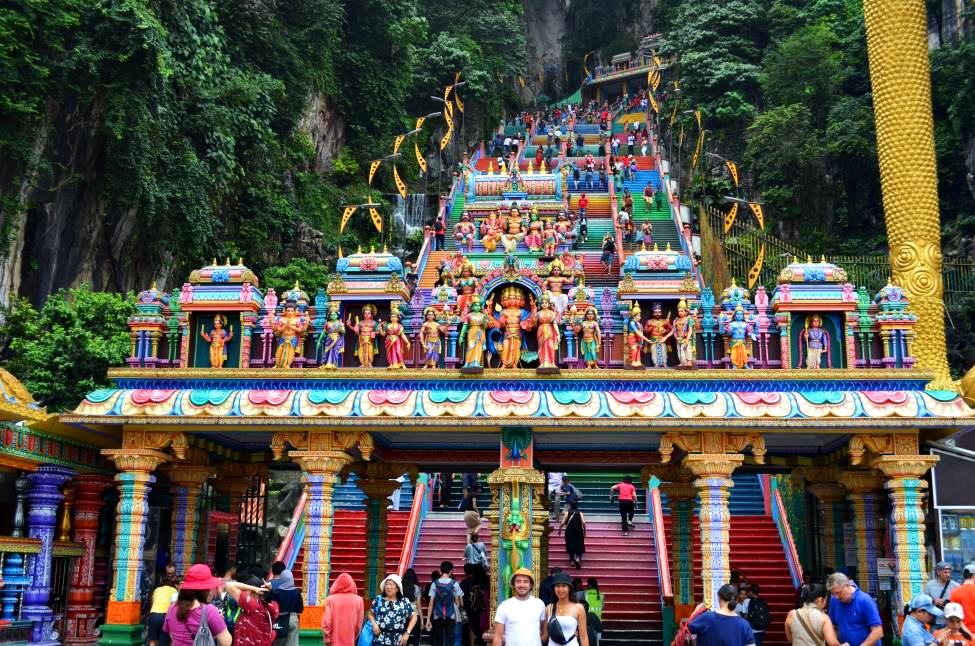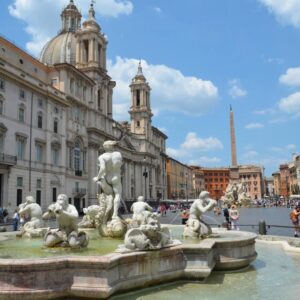BATU CAVES – Colorful Hindu shrine in Malaysia
Hindu shrines never stop to impress, but having a chance to observe them in a heavenly setting of Batu Caves in Malaysia, is facing ultimate unity of faith, nature and mankind…

Hindu deity bronze sculpture
What a privilege is to visit shining Malaysian capital Kuala Lumpur, and understand how influential religions, like Islam, Buddhism, Christianity and Hindu can walk hand in hand. Muslim population dominates the country while Hindu, represents minority. However, they had a vision on how to combine fascinating natural wander, just outside Kuala Lumpur with their Hindu deities and create legendary Batu Caves shrine.

Kuala Lumpur – Batu Caves train
While planning a visit to Batu Caves, try to be practical and save some money. Organized group tours from Kuala Lumpur will cost around 50$ per person. Instead, it is so easy and pleasant to take comfortable, air conditioned, modern train from KL Sentral to Batu Caves site. On the way, your 40 min train ride will take you through different suburbs of Malaysian Capital. Round trip price of just 4RM (Malaysian Ringgit) per person, or an equivalent to 1$, is simply nothing for such a fascinating excursion.
Arrival to Batu Caves
Arrival to Selangor district and Batu Caves train station, was instantly suggesting something unique. Large number of souvenir stalls inside the station and brightly colored statues were like a brief welcome to the world of Indian culture and Hindu religion. Always present, typical, super busy character of a Hindu shrine was so visible. Street vendors, a few on – site restaurants and hundreds of both religious and curious, non religious visitors were around . We all came together, to admire spectacular setting of a few Hindu temples, nestled among natural caves and steep, limestone mountain cliffs.
The whole story started during 1860s, when Chineese workers used to come here extracting guano from these caves to fertilize their farms. In addition, important interest to explore caves was shown by British colonial authorities and Americans as well, but real turning point came in 1891. A rich Indian merchant fascinated by the beauty of the caves, Batu river that runs the area, and the rest of untouched nature, decided to convert it into the most significant Hindu shrine outside India. After being one of the oldest religions in the nearby Indonesia, Hindu was ready for its new, grandiose chapter in Malaysia.

God Murugan and iconic Batu Caves entrance steps
among the colorful hindu temples
First sight that captures your eyes is green and gold painted statue of Lord Hanuman, guarding the entrance to the Ramayana Cave. Its dignified strong body with the face and tale of a an ape clearly suggest his status of a God, and divine monkey companion of God Rama. If this cave is opened for visitors, do not be surprised to see mostly statues and scenes from the famous Ramayana epic Hindu poem. Total of 24.000 verses describe adventures of God Rama during his exile in the deep forests of India.


Flower garlands and Cave Villa decoration
Further on, quite charming lake provides brilliant setting for the Cave Villa, maybe the most vividly painted temple of the Batu Caves complex. Enjoy diversity of yellowish, red and green altars and shrines opened for the visitors for the additional charge of 15RM (3.80$). Finally, at the end of this short stroll, one can be amazed, standing on an open square, looking at the access area of the most famous, and free of charge, Temple Cave, dedicated to God Murugan. His enormous statue, 42m (140ft) tall, guards the entrance steps.
Mighty Murugan, Hindu god of war, son of Shiva and goddess Parvati, stands with his boyish charm. He is always beautiful and the most handsome among gods, holding his spire called “Vel”. His statue adorns the square from 2006. It was built as a combination of concrete/steel shell and 300 liters of gold paint, to present divine spirit of the god. Maybe with that spirit, most of the visitors start their brave journey to climb 272 colorful, steep steps, to reach the mouth of the Temple Cave.


Monkey and My way to eternity, Batu Caves steps
Before you start, make sure to respect this holly place and avoid wearing any shorts or short skirts. In case of need, you can pay extra charge for light scarfs on site, to wrap around your body and cover your knees. On the way, amazing photo points are coming up, while huge number of curious, funny, and sometimes dangerous makaki monkeys are more than keen to meet you, and grab any type of food from your hands.

Vivid colors of the famous Temple Cave steps
Last time, my son could not resist to spend quite of time feeding them with peanuts, brought from local vendors for 7RM (1.8 $) a pack, At least we supported local economy a little bit. Half way up the steps, adventurers have a chance for a detour, and join guided tour through the Dark Cave for additional charge. Shorter – 45min, or longer – 4 hours tour, will be a real speleology expedition, with helmets and lamps to discover geological treasures and rare types of spiders.

Steps to heaven, Temple Cave
Let’s keep walking up those beautiful bright steps and finally reach the top. Immense space of the central cave gallery opens in front of you . Water is slightly dripping from the limestone ceiling, fragile stalactites hanging from above and 400 million years old massive stalagmites adorn the floor. Temple Cave acoustics, hidden niches with shrines, half in dark, additionally reflect mysticism of the place. Passing a few big altars, additional steps lead you to a magical spacious gallery. Its collapsed roof looks like an oculus to the blue sky, and dense jungle above. Wander around and dive into the world of Hindu rituals and tradition. You’ll feel profound and contemplative spirit of the place, just perfect for pilgrims while admiring temples of the Batu Caves. You can just imagine how this site looks during solemn Thaipusam Hindu festival. By the end of January, each year, over a million pilgrims gather here to honor God Murugan. Tradition ranges from painfully pierced skin on the back or forehead for penance, to carrying “kavadi”- richly decorated wooden shrines from which milk pots are hanging for faith and gratitude.
With all that staff, most faithful people march all the way to the top of the stairs. They use extra human strength to achieve their goal, here in Batu Caves complex, where blessing of Hindu gods is truly special. Leaving this holy place, every person is enriched in two ways: spiritually, due to serenity and uniqueness of the site, and physically, because of climbing 272 steps.
Reward is a privilege to experience something totally new, authentic and dignified, which Batu Caves offer to the rest of the world.

Travel Authentic. Live Inspired.
Notice: article images are made by Jonnie World Walker team.
Ready to explore more?
♣
Explore this special insight on the 130th Thaipusam Hindu Celebration in Batu Caves. Tradition, devotion, religious music and contemplation come together to glorify mighty God Murugan.
video by thestar.com
♣
Discover the essence of Hindu tradition, deep devotion of the faithful and reveal fascinating diversity of Hindu deities. This book provide a very special approach to one of the oldest religions in the world.












